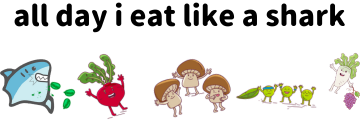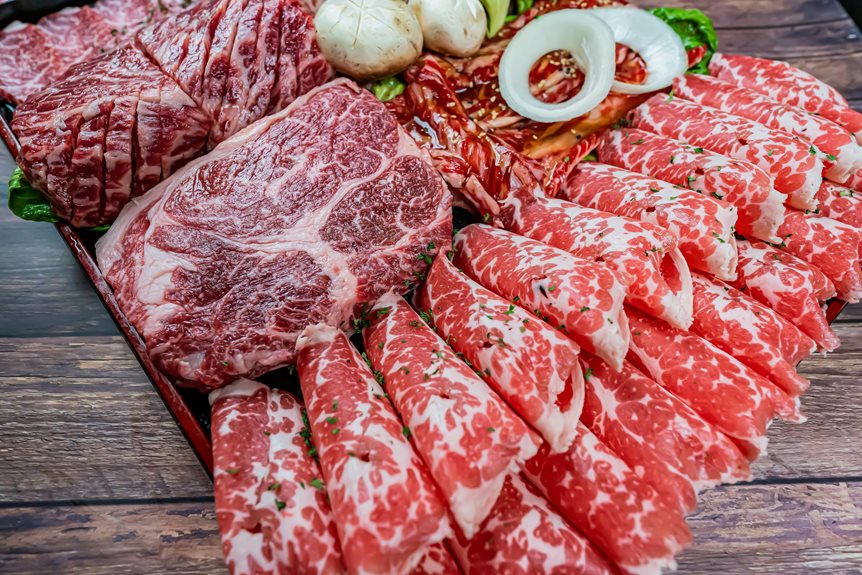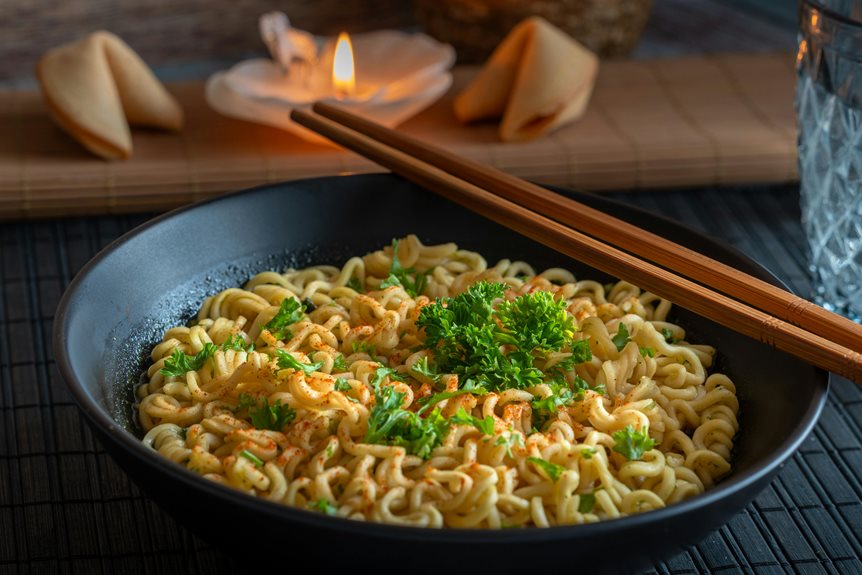You’ll find Kagoshima Wagyu beef to be Japan’s most esteemed premium beef, celebrated worldwide for its extraordinary marbling and tenderness. These cattle receive individualized care through specialized feeding practices, stress-free environments, and even occasional massages during cold months. The meat consistently achieves the highest A4 and A5 grades, with marbling scores between 8-12. Understanding the meticulous production process reveals why this beef commands such respect in culinary circles.
What Makes Kagoshima Wagyu Special
A masterpiece of culinary excellence, Kagoshima Wagyu stands out for its exceptional marbling and meticulous production standards.
You’ll find uniformly distributed intramuscular fat throughout the meat, with Beef Marbling Scores ranging from 8 to 12 for A5 grade, delivering a buttery, melt-in-your-mouth experience. The remarkable quality earned Kagoshima Wagyu the prestigious 2017 Wagyu Olympics victory.
The cattle’s stress-free lifestyle and premium diet, including rice straw, barley, and occasional seaweed, contribute to superior meat quality.
You’re guaranteed consistency through rigorous grading standards that evaluate marbling, color, firmness, and texture.
Each cut must meet strict criteria for the coveted A5 rating, ensuring you receive beef of the highest caliber.
With special labels like “Kagoshima Black” reserved for exceptional cuts, you’re investing in a product that’s carefully monitored from farm to table.
The Art of Raising Premium Cattle
While many cattle breeds are raised worldwide, Kagoshima Wagyu cattle require an exceptionally refined approach to husbandry.
You’ll find these premium cattle receiving carefully balanced diets comprising 60-70% roughage, with precise portions of protein and energy sources. They’re fed a specialized mixture two to three times daily, consuming roughly 5 tons of high-quality feed during their fattening period. The strict quality inspections throughout the feeding process ensure optimal nutrition delivery.
You can’t overlook the importance of their living conditions. These cattle thrive in stress-free environments where they receive individualized attention.
They need constant access to clean water, consuming 2-3 gallons per 100 pounds of body weight. The process extends beyond basic care – you’ll find farmers implementing unique stress-reduction techniques, including massage during cold months.
This meticulous attention to detail guarantees the development of their signature marbling and superior meat quality.
Traditional Breeding Techniques
Because Kagoshima Wagyu’s exceptional quality stems from centuries of careful breeding, you’ll discover a rich heritage of traditional techniques that shaped this prestigious cattle line.
Initial selection focused on physical traits like fur coat, color, and conformation, evolving to prioritize meat quality as Japan modernized.
You’ll find a rigorous system of evaluation at work, established by the Wagyu Registry Association in 1948. This system helps you maintain strict control over breeding outcomes through progeny testing and on-station bull evaluations. The emphasis on maintaining a stress-free environment during breeding and raising contributes significantly to the meat’s tenderness and quality.
Modern genetic testing enables you to identify superior traits, particularly through the analysis of the growth hormone Exon 5. You can select preferred genotypes (BB, BC, and CC) while eliminating less desirable ones, ensuring your herd maintains the highest genetic standards for marbling, growth rate, and feed efficiency.
Exceptional Feeding Practices
Since proper nutrition forms the cornerstone of premium Wagyu production, Kagoshima’s feeding practices follow a meticulous four-stage system designed to enhance marbling and flavor.
You’ll find each stage carefully calibrated, starting with roughage-focused starter rations that develop the rumen, followed by grower rations rich in high-quality hay.
The finisher stage is where you’ll see the signature marbling develop through a precise blend of grains, including corn and barley, supplemented with protein-rich soybean meals. By-products like wheat bran contribute essential fiber to maintain digestive health.
Throughout this process, you’ll need to maintain small group management and stress-free environments to improve feed utilization.
The diet constantly adapts to each animal’s individual needs, with feed amounts increasing progressively as your cattle mature, ensuring ideal intramuscular fat deposition.
Grading and Quality Standards
To guarantee premium quality standards, Kagoshima Wagyu undergoes rigorous evaluation through the Japanese Meat Grading Association (JMGA) system.
You’ll find this system combines yield grades (A-C) and quality grades (1-5), ensuring you receive the highest caliber beef.
When you select Kagoshima Wagyu, you’re choosing beef that consistently achieves A4 or A5 classifications.
The meat must excel in multiple criteria: marbling scores between 8-12, ideal meat color, superior fat quality, and exceptional firmness.
You’ll notice the yield grade ‘A’ indicates over 72% usable meat from the carcass, while the quality grade ‘5’ confirms outstanding marbling, texture, and color.
Local judges meticulously examine each cut using traditional Japanese techniques, and exceptional pieces may earn the prestigious “Kagoshima Black” designation. These expert evaluators also assess the meat’s potential performance in traditional cooking styles like sukiyaki and yakiniku.
Global Market Impact
While demand for premium meat products continues to surge worldwide, Kagoshima Wagyu beef has emerged as a dominant force in the global luxury food market.
You’ll find this exceptional meat in high-end restaurants, luxury hotels, and gourmet establishments, where discerning customers seek its unmatched quality.
The market’s trajectory is compelling – expanding from $2.53 billion in 2024 to a projected $42.30 billion by 2032.
Japan’s total beef consumption reached 880.43 thousand tonnes in 2022-2023, highlighting the significant market potential for premium Wagyu products.
Japan’s thriving culinary tourism has amplified Kagoshima Wagyu’s international presence, though supply remains limited due to strict production standards.
You’ll notice the market faces challenges from competitors like Kobe and Angus beef, but Japan’s strategic response includes doubling cattle output to 300 thousand tons by 2035.
This expansion, coupled with technological advancements and supportive policies, positions Kagoshima Wagyu for sustained market dominance.
Award-Winning Excellence
Kagoshima’s market dominance isn’t just about numbers – it’s backed by consistent excellence in competition. At the 2022 Zenkyo national wagyu exhibition, known as the “Wagyu Olympics,” Kagoshima claimed top prizes in six out of nine categories, facing fierce competition from 41 prefectures.
You’ll find their achievements particularly impressive: they’ve secured the prime minister’s award for best breeding cattle twice, dominated the overall contest scores in both 2017 and 2022, and had three cows win the Prime Minister’s Prize in the Breeders’ Division.
Their cattle excel in critical judging criteria, from fat quality rich in oleic acid to ideal body shape and facial features. With their Geographical Indication status and A5 Wagyu’s renowned intense marbling, Kagoshima’s position at the pinnacle of wagyu excellence is undisputed. The competition’s young representative, Shintaro Ochiai, aged 26, demonstrated the prefecture’s dedication to maintaining high breeding standards.
From Farm to Table: Production Process
Behind every prized cut of Kagoshima Wagyu lies a meticulous production process that spans several years.
You’ll find that farmers start with carefully selected Japanese Black cattle, applying sophisticated breeding programs to enhance desirable traits like marbling and growth rates. The selection process heavily relies on DGAT1 and SCD1 genes that determine fat composition and deposition in the meat.
During the extended fattening period, which can last up to 30 months, you’ll see cattle receiving a specialized high-energy diet of grains, rice straw, and supplements.
This guarantees the signature marbling that sets Kagoshima Wagyu apart. You can trust that each animal receives individualized attention in small-scale farms, where stress-free environments and detailed record-keeping are paramount.
The process demands precise monitoring of weight gain, backfat thickness, and growth ratios, while strict regulations and grading systems assure you’re getting the finest quality beef available.







Konnichiwa! (Hello!) I'm Pat Tokuyama, a Japanese tofu cookbook author, who travels for music, food, and adventure. If you like Japanese tea, checkout some of the newestorganic japanese tea, matcha bowls and noren and more!
** Curious about the Plant Based Japanese Cooking Club? ** Learn more here!